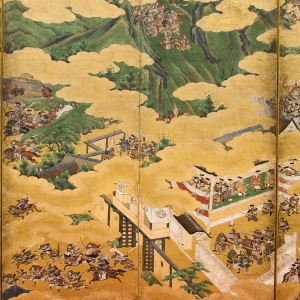The word samurai, "the one who serves", refers to members of the military caste. The samurai dominated Japan for almost seven centuries, forming the political-administrative structure of the country from 1185 to 1868. The territory was divided into fiefdoms(han) controlled by clans led by feudal lords (daimyō) and, above these local authorities, there was a 'generalissimo' (shōgun), head of the supreme military government (bakufu). The warrior's life was made up of not only military (bu), but also civil, bureaucratic and administrative (bun) prerogatives and duties.
Until 1868, the date of the beginning of the modernization of Japan, the warrior caste profoundly shaped society and culture, with incalculable impact: as patron of literature and classical Nō theatre, commissioning works in painting, sculpture, architecture and applied arts. It also employed a vast class of artists and craftsmen, linked to their patrons by a vassal relationship, who made the ornaments and equipment for war, hunting and riding necessary for the samurai: swords, weapons, saddles, (First Gallery, display case 9), helmets and war masks (First Gallery, display case 8) cuirass and armour (Fifth Gallery).
Folding screen depicting the battle of Yashima

Folding screen depicting the battle of Yashima

Folding screen depicting the battle of Yashima

Folding screen depicting the battle of Yashima





